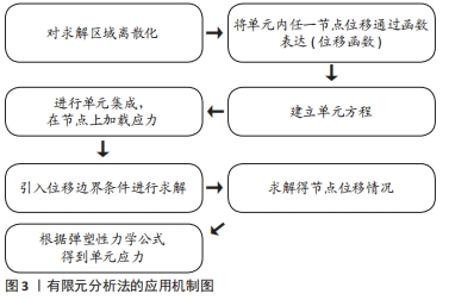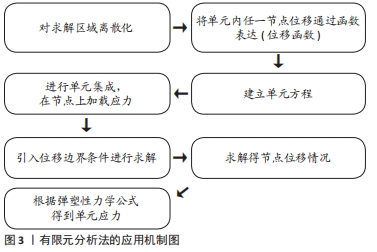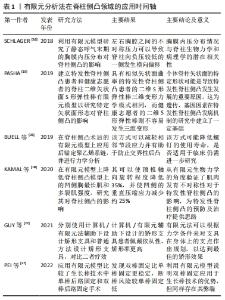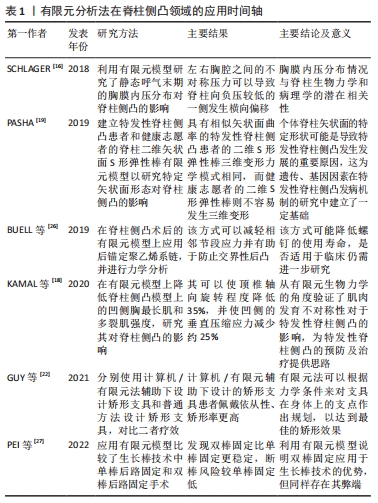Chinese Journal of Tissue Engineering Research ›› 2023, Vol. 27 ›› Issue (18): 2921-2927.doi: 10.12307/2023.342
Previous Articles Next Articles
Application of finite element analysis in spine surgery
Gao Xu1, Xing Wenhua2
- 1Inner Mongolia Medical University, Hohhot 010030, Inner Mongolia Autonomous Region, China; 2Second Affiliated Hospital of Inner Mongolia Medical University, Hohhot 010030, Inner Mongolia Autonomous Region, China
-
Received:2022-04-09Accepted:2022-06-15Online:2023-06-28Published:2022-09-19 -
Contact:Xing Wenhua, MD, Professor, Chief physician, Master’s supervisor, Second Affiliated Hospital of Inner Mongolia Medical University, Hohhot 010030, Inner Mongolia Autonomous Region, China -
About author:Gao Xu, Master candidate, Inner Mongolia Medical University, Hohhot 010030, Inner Mongolia Autonomous Region, China -
Supported by:Science and Technology Planning Project of Inner Mongolia Autonomous Region, No. 2019GG076 (to XWH); Graduate Research in Inner Mongolia Autonomous Region Innovation Fund Project, No. S202102039Z (to GX)
CLC Number:
Cite this article
Gao Xu, Xing Wenhua. Application of finite element analysis in spine surgery[J]. Chinese Journal of Tissue Engineering Research, 2023, 27(18): 2921-2927.
share this article
Add to citation manager EndNote|Reference Manager|ProCite|BibTeX|RefWorks

2.1 有限元分析法在脊柱侧凸中的应用 脊柱侧凸是脊柱畸形中的常见类型,是指脊柱在三维空间的扭曲,包括水平面上的椎体旋转、冠状面上脊柱向侧方弯曲及矢状面上前、后凸角度的增加或者减少,一般以冠状面上Cobb’s角≥10°作为诊断标准[13]。脊柱侧凸主要包括发育性脊柱侧凸和退行性脊柱侧凸,而发育性侧凸又可分为先天性脊柱侧凸和青少年特发性脊柱侧凸。脊柱侧凸的发病率在2%-5%,而其中大约80%的病例是青少年特发性脊柱侧凸。当Cobb’s角达到30°并继续进展时,就会出现背痛、呼吸循环等方面的并发症和其他生理问题,还会导致与外形相关的心理方面问题的产生,甚至可能导致死亡[14]。所以在脊柱侧凸的治疗过程中,制定科学严谨的方案尤为重要,特别是在手术治疗中,不同手术方案的选择决定了手术操作的难度及疾病的预后。 有限元分析法已广泛应用于脊柱侧凸病因研究、支具治疗及手术治疗等的生物力学分析中[15]。 2.1.1 有限元分析法在脊柱侧凸发生机制研究中的应用 青少年特发性脊柱侧凸的发生机制尚不明确,随着研究的不断深入,近年来关于青少年特发性脊柱侧凸机制的研究逐渐由单因素向多因素发展,并逐渐开始研究力学因素在青少年特发性脊柱侧凸发生发展中的作用。 SCHLAGER等[16]建立了有限元模型并研究了静态呼气末期的胸膜内压分布对脊柱侧凸的影响,该研究表明左右胸腔之间的不对称压力可以导致脊柱向负压较低的一侧发生横向偏移,而肋骨背侧的压力差可以导致椎体旋转,加速了脊柱侧凸的进展。该研究证实了胸膜内压与脊柱生物力学和病理学(如青少年特发性脊柱侧凸)的潜在相关性,为日后利用平衡胸膜内压以治疗青少年特发性脊柱侧凸提供思路,但目前需要真实病例的胸膜内压数据对这一假设加以验证。 肌肉发育对于特发性脊柱侧凸的发生发展有着至关重要的作用,这也是目前对于该疾病发生机制的主要假设之一。VAN DER PLAATS等[17]研究发现单侧肌肉延迟生长会导致肌肉发育不对称,这可能引起脊柱侧凸。KAMAL等[18]在有限元模型上降低脊柱侧凸模型上的凹侧胸最长肌和多裂肌强度,发现其可以使顶椎轴向旋转程度降低35%,并使凹侧的垂直压缩应力减少约25%,这可以减缓脊柱侧凸的进展。该研究从有限元生物力学的角度验证了肌肉发育不对称性对于特发性脊柱侧凸的影响,同时也为特发性脊柱侧凸的早期治疗提供思路,例如对椎旁肌肉发育进行干预以减缓脊柱侧凸进展。 有研究者提出特发性脊柱侧凸只在特定人群中有患病倾向,PASHA[19]分别建立特发性脊柱侧凸患者和健康志愿者的脊柱二维矢状面S形弹性棒有限元模型,在模型上加载垂直压缩应力,发现具有相似矢状面曲率的特发性脊柱侧凸患者的二维S形弹性棒三维变形力学模式相同,而健康志愿者的二维S形弹性棒则不容易发生三维变形。这项研究证明个体脊柱矢状面的特定形状可能是导致特发性脊柱侧凸发生发展的重要原因,这为遗传、基因因素在特发性脊柱侧凸发病机制的研究中建立了一定基础。 青少年特发性脊柱侧凸病因及机制的研究有建设性意义,在机制的研究上有突破对该疾病的预防及治疗有促进作用,从而使特发性脊柱侧凸的诊疗水平更高。而该项研究涉及了病理、生理及遗传等各个方面,是一个十分复杂的过程,虽然目前已取得一定的进展,但可能仍有许多发病原因和机制有待探索。有限元方法虽然可以从力学角度说明部分脊柱侧凸的病理机制,但尚缺乏动物实验及人体生物力学分析加以验证,但其探索的过程是积极的,可以为特发性脊柱侧凸的预防及治疗提供一定的思路。 文章总结了有限元分析法的应用机制,见图3。 "


2.1.2 有限元分析法在脊柱侧凸支具治疗中的应用 支具治疗是目前公认的减缓脊柱侧凸进展的非手术治疗方式,适用于Cobb’s角为20°-45°的脊柱侧凸治疗[20]。但由于人体力学情况复杂,在设计支具时需充分考虑支具在身体上的支点以确保佩戴支具后使疾病得到有效治疗。而且由于佩戴者多为儿童,制作包裹性太强的支具会降低患儿的依从性,使支具失去意义,这对支具的设计提出了更高的要求。有研究表明,计算机/有限元方法辅助下制作的矫形支具较传统方法制作的支具矫形率、保持率更好,并且具有更高的患者满意度[21]。GUY等[22]对比了使用计算机/有限元法辅助设计制作矫形支具及不使用计算机/有限元法设计制作支具的2组疗效,发现:两组的矫形率无显著差距,但计算机/有限元法辅助设计的矫形支具组患者满意度及依从性更高。以往也有研究表明,通过计算机/有限元法辅助设计支具可以缩短设计时间,减少材料使用以降低患者的包裹感和不适感,但不会影响支具的可靠性和矫形力[23-25]。 支具治疗作为脊柱侧凸保守治疗的重要方式,对治疗青少年特发性脊柱侧凸及减缓侧凸进展有重要作用,通过有限元法可以根据力学条件来对支具在身体上的支点作出规划,以达到最佳的矫形效果。但有限元法建模成本高,而支具治疗需要根据身体的变化定期更换支具,其高昂的费用使该方法设计支具多用于科研阶段,很少指导临床使用。 2.1.3 有限元分析法在脊柱侧凸手术治疗中的应用 当脊柱侧凸Cobb’s角≥45°时,就应考虑手术治疗。有限元法可以模拟后路松解、置钉及上棒等操作,可以在术前设计手术方案,缩短手术时间,提高手术安全性,减少出血量;同时可以避免医生在学习过程中尸体标本不足和可重复性差的问题,缩短医生的学习时间,展现出了不可替代的优势。 自1984年CD系统问世以来,三维矫形理论为脊柱矫形开创了新局面,但由于特发性脊柱侧凸矫形固定节段长,也带来了许多并发症。长节段融合手术已经成为治疗青少年特发性脊柱侧凸的主要方式,但其具有固定节段长、影响生长发育的局限性,并由此带来许多并发症。近端交界性脊柱后凸畸形是长节段器械脊柱融合治疗脊柱畸形的最常见并发症,可能导致疼痛、畸形进展、神经功能损伤等严重并发症,严重者需要进行翻修手术。BUELL等[26]在脊柱侧凸术后的有限元模型上应用后锚定聚乙烯系链,并进行力学分析,发现该方式可以减轻相邻节段应力并有助于防止交界性后凸,但在椎弓根螺钉上使用后锚定聚乙烯系链会加重螺钉载荷,这可能降低螺钉的使用寿命,该结果表明有必要进行系绳配置和张力影响近端交界性脊柱后凸的生物力学研究,并进行进一步的临床研究。 近年来新兴的非融合技术应用于青少年特发性脊柱侧凸畸形的治疗,生长棒技术是指在初次手术中置入生长棒内固定物,实现对脊柱畸形的部分矫正,并定期行撑开手术,这可以保留生长发育潜能,减少对胸廓发育的影响。传统生长棒技术多为单棒固定,而单棒应力集中,断棒风险高。PEI等[27]应用有限元模型模拟了生长棒技术中单棒后路固定和双棒后路固定手术,发现双棒固定比单棒固定更稳定,断棒风险较单棒固定低,但该术式由于双棒固定应力较集中,使得活动度较大的头端的邻近节段会代偿更多的力,这可能会增加头端邻近节段交界性后凸的发生风险。由于在生长过程中脊柱的生长本身会使断棒风险增加,所以在术式的选择上要考虑到固定节段及年龄等因素。 传统生长棒技术需要多次手术撑开以适应生长发育需要,这极大增加了患者的经济压力及心理负担,近年来探索的磁控生长棒技术不仅具有传统生长棒不影响脊柱生长、胸及肺部发育的优势,还可以减少手术次数,可以利用磁力控制生长棒的延长,待发育成熟后施以融合手术完成矫形[28]。但这项技术同样存在生长棒断裂、磁控生长棒延长时产生的金属碎屑引起患者金属中毒等方面的问题,故此项技术的发展仍需要材料学的支持。 有限元分析法在脊柱矫形手术中的应用提高了脊柱矫形手术的安全性,特别是该技术的应用为脊柱矫形提供了更多的手段和方法,但目前该技术仍多应用于手术方案的制定、骨性结构及内置物应力研究的阶段,未来如将有限元分析法与虚拟现实技术等结合起来应用于术中指导是值得期待的。 作者通过检索文献并归纳总结,现阶段关于脊柱侧凸生物力学分析的有限元分析法应用分类:①有助于更好地了解青少年特发性脊柱侧凸病因的研究;②改善中度脊柱侧凸病例支具管理的研究;③改善严重脊柱畸形手术策略的研究。脊柱畸形作为一种常见但难治性疾病,利用有限元分析法可以实现精准且安全的治疗,目前有限元分析法应用于脊柱侧凸仍存在一定的局限性,但其在科研、诊疗方案发展中的作用具备临床价值,有限元分析法在脊柱侧凸领域的应用进展,见表1。 "


2.2 有限元法在胸腰段脊柱骨折中的应用 脊柱骨折十分常见,占全身骨折的5%-6%,脊柱损伤常发生在胸腰段,占脊柱损伤的28%-58%[29]。胸腰段骨折常常导致患者出现胸腰椎不稳定,若不及时行内固定治疗可能会导致相应节段的脊髓损伤加重,严重者可导致瘫痪,为患者、家庭及社会带来巨大的损失及负担。胸腰椎后路手术通过使用椎弓根螺钉固定椎体的前中后三柱来为椎体提供坚强的内固定,避免脊髓或马尾神经损伤进一步加重,虽然椎弓根螺钉固定在临床上取得了满意的临床效果,但是也有部分患者出现螺钉松动、断钉等不良并发症。有限元法在建立脊柱骨折的数字化模型、分析预测脊柱骨折发生的机制,及脊柱骨折的治疗等方面体现出了巨大价值。 2.2.1 有限元分析法在脊柱骨折机制研究中的应用 骨质疏松是脊柱骨折的重要原因之一,作为一种退行性疾病,低骨量导致的椎体强度变低常导致老年人在摔倒后发生脊柱压缩性骨折[30]。ANITHA等[31]利用有限元模型研究发现,骨质疏松和椎间盘退变相互作用使椎体压缩性骨折的风险增高,骨质疏松导致椎体强度下降,而椎间盘退变则会导致其缓冲及负重能力下降,这两种机制相互作用导致了老年脊柱压缩性骨折的高发。所以对于老年人积极的抗骨质疏松治疗尤为重要,可以预防骨质疏松性骨折的发生。 暴力作为导致脊柱骨折发生的直接因素,其机制的研究具有重要意义。QIU等[32]利用脊柱有限元模型研究发现,当垂直压缩暴力发生时,应力最大的部位位于临近髓核的终板中心,力量由终板向椎体中心的松质骨传导,最终导致脂肪和骨髓被挤出,引起椎体的前后缘分别向前方后方破裂,而突入后方的骨折片则有可能压迫脊髓。ZENG等[33]在有限元模型上施加轴向暴力时,应力集中在伤椎的上后部区域,当模拟切除伤椎的上关节突后,伤椎后上方的应力峰消失。说明当脊柱骨折发生时,伤椎的应力会以剪切力的形式从上关节突传导到椎体后上方,因此当发生爆裂性骨折时椎体后缘易进入椎管。 利用有限元分析法可以对于看不到的骨折机制进行可视化还原,并可以对一些可能的假设进行验证,从而对脊柱骨折的预防、治疗等方面进行干预。但目前的研究多为间接暴力在骨折中的作用机制,尚缺乏直接作用力在脊柱骨折中的作用原理研究,而且现阶段已建立的模型多为静态模型,而缺乏动态模式下的脊柱骨折力学分析,在未来的脊柱骨折生物力学研究中应进一步探索。 2.2.2 有限元分析法在脊柱骨折手术治疗中的应用 脊柱骨折手术以复位、固定伤椎,为伤椎创造有利的恢复条件为原则,因此脊柱骨折的复位手术应尽可能的为伤椎创造一个稳定的环境,有限元法可以分析脊柱各节段的应力,因此在脊柱骨折手术治疗中有限元法得以应用。BASARAN等[34]利用有限元模型分别模拟了长节段和短节段固定T12骨折的手术过程,长节段固定为T10、T11、L1、L2椎体的撑开固定,短节段固定为T11、T12、L1椎体的撑开固定,经过静态、动态生物力学分析发现长段固定可以减少脊柱整体应力,特别是伤椎应力可以大幅度降低,为伤椎的恢复创造了有利条件,但长节段固定对相邻椎体造成了较大应力;而短节段固定足以创建安全可靠的稳定系统并可以使相邻椎体尽可能少受损伤:因此,不论是长节段还是短节段固定都可以为伤椎的恢复创造稳定的条件,且短节段固定具有创伤小、出血少、费用低、不损伤相邻椎体的优势。LIU等[35]利用单轴椎弓根螺钉、多轴椎弓根螺钉及2种螺钉的混合方案模拟脊柱骨折后路内固定手术,发现单轴椎弓根螺钉置于靠近尾端的椎体可以作为固定钉,多轴椎弓根螺钉置于中间椎体或者靠近头端的椎体时,可以有效利用张力带效应来复位伤椎。脊柱骨折术后为减轻邻近节段应力,待伤椎达到骨性愈合后会取出内固定装置,而内固定装置取出后原钉道的强度能否达到支撑椎体的强度,LIU等[36]利用有限元模型模拟椎弓根螺钉取出后的钉道,发现钉道的强度与骨皮质强度相同,取出螺钉后不会降低椎体的生物力学稳定性和强度。有限元分析法用于指导脊柱骨折手术可以达到精准治疗脊柱骨折的目的,其通过力学分析可以减少固定椎体,降低并发症发生的可能性,在脊柱骨折可视化治疗方面具有不可比拟的优势。 在应用骨水泥治疗骨质疏松性椎体骨折时,应注意骨水泥的用量,WANG等[37]在有限元模型上模拟椎体压缩性骨折骨水泥注入时发现,椎体成形术可能导致邻近椎体的生物力学变化,在有垂直方向载荷的情况下,相邻椎体的应力随着注射的骨水泥量增加而显著增加,导致相邻椎体的骨折风险增加。因此在临床工作中应注意骨水泥的注入量,切莫过度追求椎体的解剖复位。关于骨水泥材料研究正是由此展开的,以往研究者们认为,聚甲基丙烯酸甲酯水泥与骨组织的密度存在差异,应用于椎体骨折的复位增加了邻近节段骨折的风险,而无铝玻璃聚烯酸酯水泥与骨组织的密度及强度存在相似性。MEYER等[38]利用有限元模型研究了两种骨水泥注入椎体后的应力,发现无铝玻璃聚烯酸酯水泥在椎体成形术后对相邻椎体产生较低的应力,具有有利的生物力学特征,可以应用于临床。 脊柱骨折作为一种常见病,其发生机制的研究有利于预防骨折的发生,并可以指导治疗,而在治疗过程中,研究者们需注意手术风险以及手术可能造成的并发症。由于有限元分析法在力学分析方面具备优势,所以对于多由暴力造成的脊柱骨折方面的研究可以加以推广。 2.3 有限元法在退行性椎间盘疾病中的应用 据报道,椎间盘退行性疾病与遗传、生物力学、解剖学变异有很大的关系[39]。椎间盘退变性疾病可以引起颈部疼痛、上肢的麻木疼痛、下腰痛及下肢的麻木疼痛,严重者会出现瘫痪等严重后果,这将给个人、家庭、社会带来沉重负担,故而研究椎间盘退行性疾病的发病原因及发病机制极为重要,而由于脊柱后路手术涉及脊髓、神经,术后涉及到脊柱的运动及生物力学等问题,因此严格手术方案的制定对于椎间盘退行性疾病的治疗尤为重要。 2.3.1 有限元分析法在退行性椎间盘疾病机制研究中的应用 椎间盘具有强大的吸水能力,部分原因是髓核及纤维环中的糖胺聚糖含量高,其含量从中心的髓核到周围的纤维环呈下降趋势。糖胺聚糖在椎间盘的分布有助于提高椎间盘的应力值和形变能力,这种能力在髓核中可以抵抗垂直压缩应力,在纤维环可以抵抗张力。当发生轻至中度退变时,髓核中的糖胺聚糖减少,在有限元模型中分析得出椎间盘的膨胀能力和对抗垂直压缩应力的能力降低了50%以上,这可能会增加椎间盘撕裂的风险[40]。RUIZ WILLS等[41]在研究软骨终板对于椎间盘退变的影响时,建立了腰椎的三维有限元模型,发现软骨终板变性后在机械负载下会导致椎间盘更快丧失水分,并且阻碍营养物质向椎间盘扩散,这进一步促进了椎间盘退变。分子生物学与有限元法的结合为椎间盘退变的研究提供了新的方向,为分子生物学在机械负载下研究椎间盘退变提供了新的方向,但此类型的研究仍停留在生物力学和分子生物学的相互作用上,暂无有关综合因素作用于椎间盘退变的报道。 2.3.2 有限元分析法在退行性椎间盘疾病手术治疗中的应用 随着手术技术的不断进步,腰椎间盘退行性疾病的融合方式呈现多样化。LU等[42]比较了各种类型融合方式的力学状态,发现后外侧融合术的稳定性低于其余融合方式,经生物力学分析发现其活动度和应力较集中,这可能与后路手术受到手术操作通道较小只能置入较小的椎间融合器有关,而斜外侧融合术和极外侧融合术在终板及骨皮质的应力更小,这有利于增大融合器下沉阻力,维持椎间隙高度,可以带来更好的治疗效果,有效避免术后并发症。但经椎间孔融合手术和斜外侧融合术对于邻近节段的影响也很大,WANG等[43]利用有限元法比较经椎间孔融合术和斜外侧融合术对腰椎邻近节段的影响,发现两种融合方式在所有运动模式中都增加了邻近节段的应力。LI等[44]在有限元模型上研究颈前路椎间盘切除融合术对邻近节段的影响,发现颈前路椎间盘切除融合术后邻近节段的生物力学变化应力增加,有可能加速邻近节段的退变。 脊柱融合手术会增加邻近节段退变的风险,融合术后邻近节段的退变会导致严重问题,如邻近节段的腰椎滑脱、椎管狭窄、椎间盘突出甚至邻近节段应力增加导致的骨折等。所以选择融合手术作为治疗患者椎间盘退变疾病的治疗方案要极为谨慎,而具体哪种融合方式的选择还应以患者的临床表现、邻近节段的生理状态等具体情况来决定。 针对以上问题,近年来提出并逐步在临床上推广使用的腰椎弹性固定可以减少邻近节段的应力,其在固定后限制脊柱过度活动的同时,还可以保留一定的脊柱活动度。根据固定方式及部位的不同,脊柱弹性固定主要有人工椎间盘置换、棘突间内固定、椎板间内固定及经椎弓根动态内固定几类,目前主流的方案主要包括K-Rod动态系统、通用动态腰椎固定系统和 Dynesys系统[45]。但作为动态内固定方式,这类固定方案对内固定材料提出了更高要求,其在保留脊柱活动度的同时容易发生螺钉松动及钉棒断裂等风险。 目前仍多采用CT作为原始资料构建有限元模型,该技术对骨性结构的建模比较准确,而对于椎间盘等软组织的构建有所欠缺,在日后利用核磁建模的技术发展成熟后研究者们可以更准确地分析椎间盘的应力及退变机制等情况。 2.4 有限元法在骨质疏松研究中的应用 骨质疏松症的定义是低骨量和骨结构紊乱,导致骨强度受损和骨折风险增加。骨质疏松症也被认为是一种沉默的疾病,因为骨质疏松患者第一次出现症状便是骨折,这是该病症最严重的并发症。脊柱椎体骨折是最常见的骨质疏松性骨折,但也是最不容易被发现的骨折。OSTA基于亚洲8个国家和地区绝经后妇女的研究,收集多项骨质疏松危险因素,得出能较好体现敏感度和特异度的两项简易筛查指标,即年龄和体质量[46]。OSTA指数=[体质量(kg)-年龄(岁)]×0.2,OSTA指数 > -1为骨质疏松低风险人群,OSTA指数为-1至-4为骨质疏松中等风险人群,OSTA指数< -4为骨质疏松高风险人群。 就骨质疏松症而言,有许多研究使用有限元模型来评估骨质疏松的骨折风险、治疗、生物力学。特别是,非线性CT/FEA对于骨质疏松骨折比脊柱骨密度检查具有更显著的能力[47]。因此,CT/FEA可作为替代骨密度检查来分析骨质疏松相关骨折。对于骨质疏松症治疗,CT/FEA有助于研究特立帕肽和阿仑膦酸盐药物对脊柱骨质疏松的疗效[48-49]。此外, CT/FEA研究表明,CT/FEA的椎体压缩力比骨密度更好地预测椎体骨折,并且可以比骨密度检查更早地用于评估药物的作用[48-49]。 ZHANG等[50]构建了基于CT图像的三维有限元模型,并证明了三皮质椎弓根螺钉技术应用于骨质疏松的胸椎椎体内可以增强螺钉的把持力,降低椎弓根螺钉松动的风险。GUO等[51]在骨质疏松压缩性骨折有限元模型中利用骨水泥增强椎弓根螺钉,证明了在短节段椎弓根螺钉中使用骨水泥增强可以增强椎弓根螺钉的把持力,有效降低螺钉拔出的风险。 "

| [1] CAI XY, SANG D, YUCHI CX, et al. Using finite element analysis to determine effects of the motion loading method on facet joint forces after cervical disc degeneration. Comput Biol Med. 2020;116:103519. [2] WELCH-PHILLIPS A, GIBBONS D, AHERN DP, et al. What is finite element analysis? Clin Spine Surg. 2020;33(8):323-324. [3] BREKELMANS WA, POORT HW, SLOOFF TJ. A new method to analyse the mechanical behaviour of skeletal parts. Acta Orthop Scand. 1972; 43(5):301-317. [4] BELYTSCHKO T, KULAK RF, SCHULTZ AB, et al. Finite element stress analysis of an intervertebral disc. J Biomech. 1974;7(3):277-285. [5] ZHANG Q, CHON T, ZHANG Y, et al. Finite element analysis of the lumbar spine in adolescent idiopathic scoliosis subjected to different loads. Comput Biol Med. 2021;136:104745. [6] DUPUIS S, FORTIN C, CAOUETTE C, et al. Global postural re-education in pediatric idiopathic scoliosis: a biomechanical modeling and analysis of curve reduction during active and assisted self-correction. BMC Musculoskelet Disord. 2018;19(1):200. [7] NOURRY V. 1/6 Anatomie et physiologie du rachis [Anatomy and physiology of the spine]. Soins Gerontol. 2012;(95):45-46. [8] QIU GX. Scoliosis in China: history and present status. Chin Med J (Engl). 2017;130(21):2521-2523. [9] KANO H, MATSUO Y, KUBO N, et al. Spinal injuries in suicidal jumpers. Spine (Phila Pa 1976). 2019;44(1):E13-E18. [10] YANG S, SHAO Y, YAN Q, et al. Differential diagnosis strategy between lower extremity arterial occlusive disease and lumbar disc herniation. Biomed Res Int. 2021;2021:6653579. [11] BAILEY S, STADELMANN MA, ZYSSET PK, et al. Influence of metastatic bone lesion type and tumor origin on human vertebral bone architecture, matrix quality, and mechanical properties. J Bone Miner Res. 2022;37(5):896-907. [12] HE Z, ZHANG M, LI W, et al. Finite element analysis of an improved correction system for spinal deformity. In Vivo. 2021;35(4):2197-2205. [13] GOULD SL, CRISTOFOLINI L, DAVICO G, et al. Computational modelling of the scoliotic spine: a literature review. Int J Numer Method Biomed Eng. 2021;37(10):e3503. [14] NEGRINI S, DONZELLI S, AULISA AG, et al. 2016 SOSORT guidelines: orthopaedic and rehabilitation treatment of idiopathic scoliosis during growth. Scoliosis Spinal Disord. 2018;13:3. [15] GUAN T, ZHANG Y, ANWAR A, et al. Determination of three-dimensional corrective force in adolescent idiopathic scoliosis and biomechanical finite element analysis. Front Bioeng Biotechnol. 2020;8:963. [16] SCHLAGER B, NIEMEYER F, GALBUSERA F, et al. Asymmetrical intrapleural pressure distribution: a cause for scoliosis? A computational analysis. Eur J Appl Physiol. 2018;118(7):1315-1329. [17] VAN DER PLAATS A, VELDHUIZEN AG, VERKERKE GJ. Numerical simulation of asymmetrically altered growth as initiation mechanism of scoliosis. Ann Biomed Eng. 2007;35(7):1206-1215. [18] KAMAL Z, ROUHI G. Stress distribution changes in growth plates of a trunk with adolescent idiopathic scoliosis following unilateral muscle paralysis: a hybrid musculoskeletal and finite element model. J Biomech. 2020;111:109997. [19] PASHA S. 3D Deformation patterns of s shaped elastic rods as a pathogenesis model for spinal deformity in adolescent idiopathic scoliosis. Sci Rep. 2019;9(1):16485. [20] KAELIN AJ. Adolescent idiopathic scoliosis: indications for bracing and conservative treatments. Ann Transl Med. 2020;8(2):28. [21] WEI W, ZHANG T, HUANG Z, et al. Finite element analysis in brace treatment on adolescent idiopathic scoliosis. Med Biol Eng Comput. 2022;60(4):907-920. [22] GUY A, LABELLE H, BARCHI S, AUDET-DUCHESNE E, et al. Braces designed using CAD/CAM combined or not with finite element modeling lead to effective treatment and quality of life after 2 years: a randomized controlled trial. Spine (Phila Pa 1976). 2021;46(1):9-16. [23] GIGNAC D, AUBIN CE, DANSEREAU J, et al. Optimization method for 3D bracing correction of scoliosis using a finite element model. Eur Spine J. 2000;9(3):185-190. [24] VERGARI C, COURTOIS I, EBERMEYER E, et al. Experimental validation of a patient-specific model of orthotic action in adolescent idiopathic scoliosis. Eur Spine J. 2016;25(10):3049-3055. [25] COURVOISIER A, NESME M, GERBELOT J, et al. Prediction of brace effect in scoliotic patients: blinded evaluation of a novel brace simulator-an observational cross-sectional study. Eur Spine J. 2019;28(6):1277-1285. [26] BUELL TJ, BESS S, XU M, et al. Optimal tether configurations and preload tensioning to prevent proximal junctional kyphosis: a finite element analysis. J Neurosurg Spine. 2019:1-11. [27] PEI B, LU D, WU X, et al. Effects of growing rod technique with different surgical modes and growth phases on the treatment outcome of early onset scoliosis: a 3-D finite element analysis. Int J Environ Res Public Health. 2022;19(4):2057. [28] DI SILVESTRE M, ZANIRATO A, GREGGI T, et al. Severe adolescent idiopathic scoliosis: posterior staged correction using a temporary magnetically-controlled growing rod. Eur Spine J. 2020;29(8):2046-2053. [29] BOUYER B, VASSAL M, ZAIRI F, et al. Surgery in vertebral fracture: epidemiology and functional and radiological results in a prospective series of 518 patients at 1 year’s follow-up. Orthop Traumatol Surg Res. 2015;101(1):11-15. [30] ALLAIRE BT, LU D, JOHANNESDOTTIR F, et al. Prediction of incident vertebral fracture using CT-based finite element analysis. Osteoporos Int. 2019;30(2):323-331. [31] ANITHA DP, BAUM T, KIRSCHKE JS, et al. Effect of the intervertebral disc on vertebral bone strength prediction: a finite-element study. Spine J. 2020;20(4):665-671. [32] QIU TX, TAN KW, LEE VS, et al. Investigation of thoracolumbar T12-L1 burst fracture mechanism using finite element method. Med Eng Phys. 2006;28(7):656-664. [33] ZENG ZL, ZHU R, LI SZ, et al. Formative mechanism of intracanal fracture fragments in thoracolumbar burst fractures: a finite element study. Chin Med J (Engl). 2013;126(15):2852-2858. [34] BASARAN R, EFENDIOGLU M, KAKSI M, et al. Finite element analysis of short- versus long-segment posterior fixation for thoracolumbar burst fracture. World Neurosurg. 2019;128:e1109-e1117. [35] LIU H, WANG H, LIU J, et al. Biomechanical comparison of posterior intermediate screw fixation techniques with hybrid monoaxial and polyaxial pedicle screws in the treatment of thoracolumbar burst fracture: a finite element study. J Orthop Surg Res. 2019;14(1):122. [36] LIU JM, ZHANG Y, ZHOU Y, et al. The effect of screw tunnels on the biomechanical stability of vertebral body after pedicle screws removal: a finite element analysis. Int Orthop. 2017;41(6):1183-1187. [37] WANG D, LI Y, YIN H, et al. Three-dimensional finite element analysis of optimal distribution model of vertebroplasty. Ann Palliat Med. 2020; 9(3):1062-1072. [38] MEYER C, VAN GAALEN K, LESCHINGER T, et al. Kyphoplasty of osteoporotic fractured vertebrae: a finite element analysis about two types of cement. Biomed Res Int. 2019;2019:9232813. [39] KIM HS, WU PH, JANG IT. Lumbar degenerative disease part 1: anatomy and pathophysiology of intervertebral discogenic pain and radiofrequency ablation of basivertebral and sinuvertebral nerve treatment for chronic discogenic back pain: a prospective case series and review of literature. Int J Mol Sci. 2020;21(4):1483. [40] YANG B, O’CONNELL GD. Intervertebral disc swelling maintains strain homeostasis throughout the annulus fibrosus: a finite element analysis of healthy and degenerated discs. Acta Biomater. 2019;100:61-74. [41] RUIZ WILLS C, FOATA B, GONZÁLEZ BALLESTER MÁ, et al. Theoretical explorations generate new hypotheses about the role of the cartilage endplate in early intervertebral disk degeneration. Front Physiol. 2018; 9:1210. [42] LU T, LU Y. Comparison of biomechanical performance among posterolateral fusion and transforaminal, extreme, and oblique lumbar interbody fusion: a finite element analysis. World Neurosurg. 2019;129: e890-e899. [43] WANG B, HUA W, KE W, et al. Biomechanical evaluation of transforaminal lumbar interbody fusion and oblique lumbar interbody fusion on the adjacent segment: a finite element analysis. World Neurosurg. 2019;126:e819-e824. [44] LI XF, LV ZD, YIN HL, et al. Impact of adjacent pre-existing disc degeneration status on its biomechanics after single-level anterior cervical interbody fusion. Comput Methods Programs Biomed. 2021; 209:106355. [45] 刘涛,王振江,陈凡,等.腰椎椎弓根动态内固定修复腰椎退行性疾病: K-Rod弹性棒、通用弹性棒及Dynesys系统比较[J].中国组织工程研究,2014,18(44):7111-7116. [46] WANG P, ABDIN E, SHAFIE S, et al. Estimation of prevalence of osteoporosis using OSTA and its correlation with sociodemographic factors, disability and comorbidities. Int J Environ Res Public Health. 2019;16(13):2338. [47] IMAI K, OHNISHI I, MATSUMOTO T, et al. Assessment of vertebral fracture risk and therapeutic effects of alendronate in postmenopausal women using a quantitative computed tomography-based nonlinear finite element method. Osteoporos Int. 2009;20(5):801-810. [48] IMAI K. Computed tomography-based finite element analysis to assess fracture risk and osteoporosis treatment. World J Exp Med. 2015;5(3): 182-187. [49] FEI Q, LI QJ, YANG Y, et al. Three-dimensional finite element model of thoracolumbar spine with osteoporotic vertebral compression fracture. Zhonghua Yi Xue Za Zhi. 2010;90(41):2943-2946. [50] ZHANG W, ZHAO J, LI L, et al. Modelling tri-cortical pedicle screw fixation in thoracic vertebrae under osteoporotic condition: a finite element analysis based on computed tomography. Comput Methods Programs Biomed. 2020;187:105035. [51] GUO HZ, GUO DQ, TANG YC, et al. Selective cement augmentation of cranial and caudal pedicle screws provides comparable stability to augmentation on all segments in the osteoporotic spine: a finite element analysis. Ann Transl Med. 2020;8(21):1384. [52] GOTO K, TAJIMA N, CHOSA E, et al. Effects of lumbar spinal fusion on the other lumbar intervertebral levels (three-dimensional finite element analysis). J Orthop Sci. 2003;8(4):577-584. [53] GOEL VK, MONROE BT, GILBERTSON LG, et al. Interlaminar shear stresses and laminae separation in a disc. Finite element analysis of the L3-L4 motion segment subjected to axial compressive loads. Spine (Phila Pa 1976). 1995;20(6):689-698. |
| [1] | Nong Fuxiang, Jiang Zhixiong, Li Yinghao, Xu Wencong, Shi Zhilan, Luo Hui, Zhang Qinglang, Zhong Shuang, Tang Meiwen. Bone cement augmented proximal femoral nail antirotation for type A3.3 intertrochanteric femoral fracturalysis [J]. Chinese Journal of Tissue Engineering Research, 2023, 27(在线): 1-10. |
| [2] | Hu Xijian, Zhao Bin, Chai Huo, Liu Haifeng. Application of trunk surface morphometry in vertebral column defects [J]. Chinese Journal of Tissue Engineering Research, 2023, 27(9): 1462-1468. |
| [3] | Dang Yi, Du Chengyan, Yao Honglin, Yuan Nenghua, Cao Jin, Xiong Shan, Zhang Dingmei, Wang Xin. Hormonal osteonecrosis and oxidative stress [J]. Chinese Journal of Tissue Engineering Research, 2023, 27(9): 1469-1476. |
| [4] | Jiang Xiaocheng, Shi Lu, Wang Yinbin, Li Qiujiang, Xi Chuangzhen, Ma Zefeng, Cai Lijun. Systematical evaluation of bone fusion rate after interbody fusion in patients with osteoporosis and lumbar degenerative disease treated with teriparatide [J]. Chinese Journal of Tissue Engineering Research, 2023, 27(9): 1427-1433. |
| [5] | Zhong Yizheng, Huang Peizhen, Cai Qunbin, Zheng Liqin, He Xingpeng, Dong Hang. Microstructural indexes that determine the trabecular bone maximum stress of micro-finite element models [J]. Chinese Journal of Tissue Engineering Research, 2023, 27(9): 1313-1318. |
| [6] | Cao Sheng, Kong Lingwei, Xu Kun, Sun Zhijie. Correlation of cervical sagittal force line parameters with degenerative segment and Pfirrmann classification in patients with cervical intervertebral disc degeneration [J]. Chinese Journal of Tissue Engineering Research, 2023, 27(9): 1319-1324. |
| [7] | Li Xiaomin, Tian Xiangdong, Tan Yetong, Zhu Guangyu, Wang Rongtian, Wang Jian, Xue Zhipeng, Ma Sheng, Hu Yuanyi, Huang Ye, Ding Tiansong. Changes of lower limb force line and knee function after high tibial osteotomy in osteoporotic medial ventricular knee osteoarthritis [J]. Chinese Journal of Tissue Engineering Research, 2023, 27(9): 1325-1329. |
| [8] | Wu Taoguang, Nie Shaobo, Chen Hua, Zhu Zhengguo, Qi Lin, Tang Peifu. Biomechanical characteristics of a new multi-dimensional cross locking plate in the treatment of subtrochanteric nonunion [J]. Chinese Journal of Tissue Engineering Research, 2023, 27(9): 1330-1334. |
| [9] | Peng Zhixin, Yan Wengang, Wang Kun, Zhang Zhenjiang. Finite element analysis and structural optimization design of 3D printed forearm braces [J]. Chinese Journal of Tissue Engineering Research, 2023, 27(9): 1340-1345. |
| [10] | Liu Jinyu, Zhang Hanshuo, Cui Hongpeng, Pan Lingzhi, Zhao Boran, Li Fei, Ding Yu. Finite element biomechanical analysis of minimally invasive treatment of cervical spondylotic myelopathy and accurate exercise rehabilitation [J]. Chinese Journal of Tissue Engineering Research, 2023, 27(9): 1359-1364. |
| [11] | Wen Xinghua, Ding Huanwen, Cheng Kai, Yan Xiaonan, Peng Yuanhao, Wang Yuning, Liu Kang, Zhang Huiwu. Three-dimensional finite element model analysis of intramedullary nailing fixation design for large femoral defects in Beagle dogs [J]. Chinese Journal of Tissue Engineering Research, 2023, 27(9): 1371-1376. |
| [12] | You Zhengqiu, Zhang Zhongzu, Wang Qunbo. Early symptomatic intervertebral disc pseudocysts after discectomy detected on MRI [J]. Chinese Journal of Tissue Engineering Research, 2023, 27(9): 1403-1409. |
| [13] | Pan Zhongjie, Qin Zhihong, Zheng Tiejun, Ding Xiaofei, Liao Shijie. Targeting of non-coding RNAs in the pathogenesis of the osteonecrosis of the femoral head [J]. Chinese Journal of Tissue Engineering Research, 2023, 27(9): 1441-1447. |
| [14] | Cai Zhihao, Xie Zhaoyong. Femoral neck anteversion measurement assessment: how to establish a unified method and standard [J]. Chinese Journal of Tissue Engineering Research, 2023, 27(9): 1448-1454. |
| [15] | Sun Jiajia, Zhu Haidi, Lu Yun, Zhang Kai. Comparison of bone metabolism markers between type 2 diabetes mellitus and non-type 2 diabetes mellitus patients with hip fracture [J]. Chinese Journal of Tissue Engineering Research, 2023, 27(8): 1156-1160. |
| Viewed | ||||||
|
Full text |
|
|||||
|
Abstract |
|
|||||